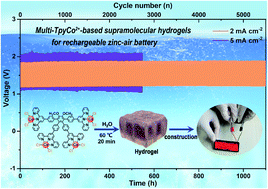Multi-TpyCo2+-based conductive supramolecular hydrogels constructed by “bridge bonds” for rechargeable Zn-air batteries with ultrastable cycling stability over 1100 h†
Abstract
For supramolecular hydrogels, a deep understanding of the gelation process and exploration of their application in rechargeable electrochemical batteries remain a significant challenge. Herein, this paper demonstrates a series of novel multi-TpyCo2+-based low-molecular-weight supramolecular hydrogelators and further discovers the spontaneous gelation mechanism by experimental and calculation results. The hydrogen bond and π–π conjugation have a synergistic driving effect in gelation. In particular, the hydrogen bond between the free Cl anion and H2O molecules serves as a “bridge bond” to connect nearby structural units, contributing to forming a stronger network structure. Owing to the difference of the spatial confinement effect of the gelator, gelled (Tpy)xCox displays a conductivity-dependent activity for the oxygen evolution reaction, and (Tpy)4Co4 presents the lowest overpotential of 264 and 301 mV at 10 and 100 mA cm−2, respectively. More importantly, with (Tpy)4Co4 as the air cathode, liquid rechargeable Zn-air batteries exhibit an ultrastable cycling stability of more than 1100 h (5500 cycles @2 mA cm−2) and a high energy efficiency of 65.3% with negligible performance decay. Moreover, the fabricated (Tpy)4Co4-based quasi-solid-state battery displays a superior stability of 270 h (1 mA cm−2 at 25 °C) and 25 h (0.5 mA cm−2 at −40 °C).



 Please wait while we load your content...
Please wait while we load your content...